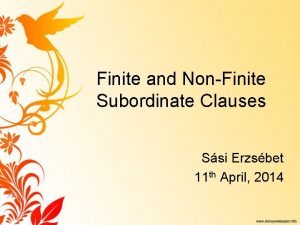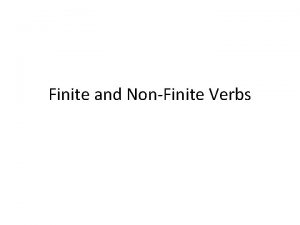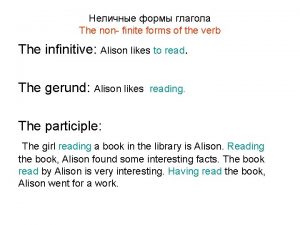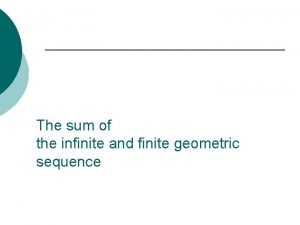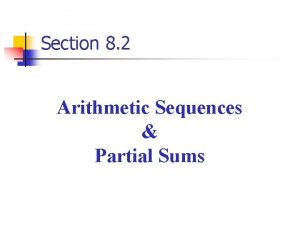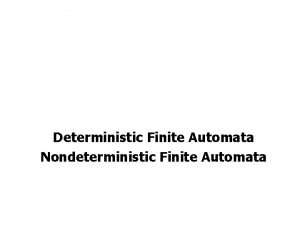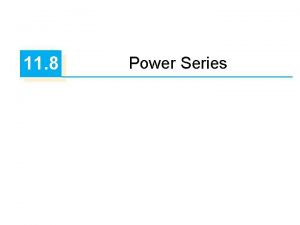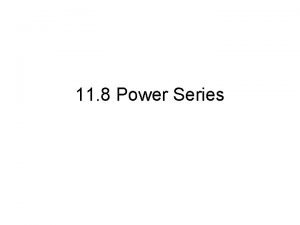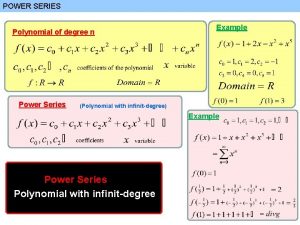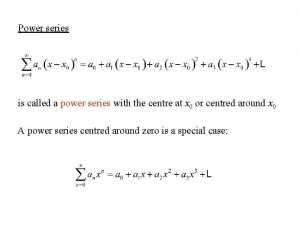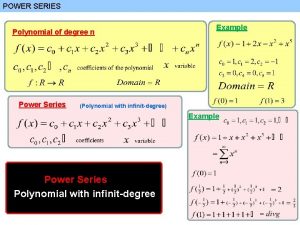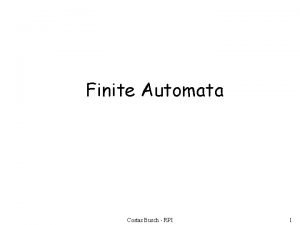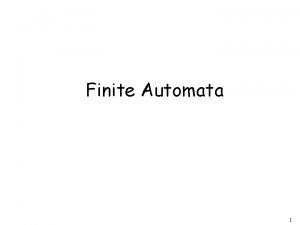Power Series Section 9 1 a A finite














- Slides: 14

Power Series Section 9. 1 a

A finite sum of real numbers always produces a real number, but an infinite sum of real numbers is not actually a real sum: Definition: Infinite Series An infinite series is an expression of the form or The numbers is the nth term. are the terms of the series;

A finite sum of real numbers always produces a real number, but an infinite sum of real numbers is not actually a real sum: The partial sums of the series form a sequence If the sequence of partial sums has a limit S as n approaches infinity, we say the series converges to S: Otherwise, we say the series diverges.

Guided Practice Does the given series diverge? Can we use the associate property of addition? : This does NOT work with infinite series!!! Instead, look at the sequence of partial sums: Since this sequence has no finite limit, then the original series has no sum. It diverges.

Guided Practice Does the given series diverge? Look at the sequence of partial sums: This sequence has a limit , which we recognize as 1/3. The series converges to the sum 1/3. This last problem is an example of a geometric series, because each term is obtained by multiplying the previous term by the same constant (1/10 in this case)…

Geometric Series The geometric series converges to the sum if , and diverges if The interval is the interval of convergence. (these are the r values for which the series converges)

Guided Practice Tell whether each series converges or diverges. If it converges, give its sum. The first term is a = 3 and r = 1/2. The series converges to: The first term is a = 1 and r = – 1/2. The series converges to:

Guided Practice Tell whether each series converges or diverges. If it converges, give its sum. The first term is a = 9/25 and r = 3/5. The series converges to: In this series, The series diverges.

Representing Functions by Series If , then the geometric series formula gives: The expression on the left defines a function whose domain is the interval of convergence, . The expression on the right defines a function whose domain is the set of all real numbers. The equality is understood to hold only in this latter domain, where both sides of the equation are defined. On this domain, the series represents the function 1/(1 – x).

Representing Functions by Series If , then the geometric series formula gives: Let’s graph the function together with some partial sums of the series. Graph in [– 4. 7, 4. 7] by [– 2, 4]: The graphs behave similarly, but only on the interval of convergence!!!

Definition: Power Series An expression of the form is a power series centered at x = 0. An expression of the form is a power series centered at x = a. The term the nth term; the number a is the center. is

Guided Practice Given that 1/(1 – x) is represented by the power series on the interval (– 1, 1), find a power series that represents 1. on 2. on 3. on

Guided Practice Given that 1/(1 – x) is represented by the power series on the interval (– 1, 1), find a power series that represents 4. and give its interval of convergence This geometric series converges for: Interval of convergence:

Guided Practice Given that 1/(1 – x) is represented by the power series on the interval (– 1, 1), find a power series that represents 5. This geometric series converges for: and give its interval of convergence Interval of convergence:
 Finite power series
Finite power series Finite subordinate clause
Finite subordinate clause Learning objectives for finite and non finite verbs
Learning objectives for finite and non finite verbs Learning objectives of non finite verbs
Learning objectives of non finite verbs How to find finite and nonfinite verbs
How to find finite and nonfinite verbs Non finite forms of the verb qayda
Non finite forms of the verb qayda Sum of geometric sequence
Sum of geometric sequence Sum of a finite arithmetic series
Sum of a finite arithmetic series Arithmetic sequence sigma notation
Arithmetic sequence sigma notation Geometric formula
Geometric formula Geometric series formula
Geometric series formula Power traiangle
Power traiangle Maclaurin series vs taylor series
Maclaurin series vs taylor series Heisenberg 1925 paper
Heisenberg 1925 paper Taylor series of composite function
Taylor series of composite function

